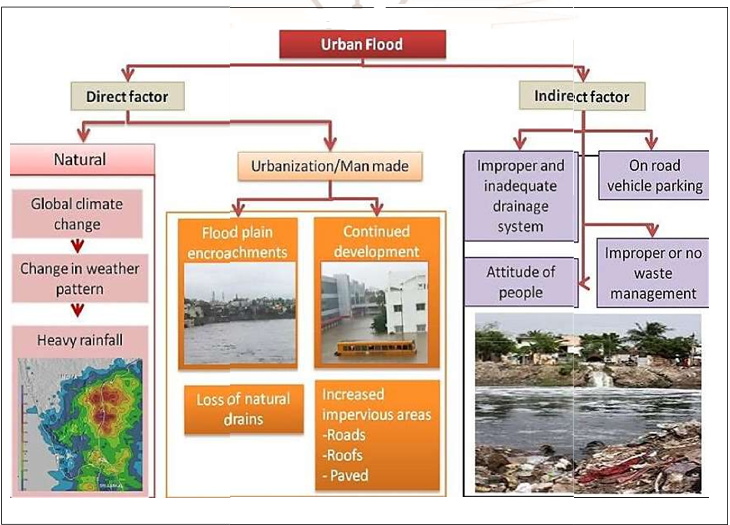Urban flooding has become a common occurrence these days in India. A number of metro cities in the country including Mumbai, Chennai, Delhi and Bengaluru have suffered from it.The latest victim of urban flooding is Hyderabad. The city as well as Telangana received unusually excessive rainfall in October 2020, due to a deep depression that developed in the Bay of Bengal.
Urban flooding is significantly different from rural flooding as urbanization leads to developed catchments, which increases the flood peaks from 1.8 to 8 times and flood volumes by up to 6 times.Urban areas are densely populated and people living in vulnerable areas suffer due to flooding, sometimes resulting in loss of life. It is not only the event of flooding but the secondary effect of exposure to infection also has its toll in terms of human suffering, loss of livelihood and, in extreme cases, loss of life.
Causes of Urban Floods:

Causes of floods in Hyderabad:
- The city received unusually excessive rainfall October 13-14, 2020, due to a deep depression that developed in the Bay of Bengal. Heavy damage to property, roads, and human lives has been reported.
- The city of Hyderabad doesn’t usually get flooded due to monsoonal rain. There is a natural system of flow of water from a high elevated area to a lower one. But Lakes in the town have shrunk due to encroachment. Most of the former waterways are open sewers now.
- Large water bodies that existed for centuries have shrunk in size, encroachments have eaten into natural waterways, and storm water drains get easily clogged.
- Mismanagement of urban water bodies and lakes.
Measures to address issue of Urban Flooding:
- Using wetlands: Issues of incremental land use change, particularly of those commons which provide us with necessary ecological support like wetlands need to be acknowledged. The holding capacity of wetlands helps control floods. Preserving and restoring wetlands together can often provide the level of flood control otherwise provided by expensive dredge operations and levees. We need to start paying attention to the management of our wetlands by involving local communities.
- Concept of Sponge cities: The idea of a sponge city is to make cities more permeable so as to hold and use the water which falls upon it. Sponge cities absorb the rain water, which is then naturally filtered by the soil and allowed to reach urban aquifers. This allows for the extraction of water from the ground through urban or peri-urban wells. This water can be treated easily and used for city water supply.
- Collaborative approach: The Metropolitan Development Authorities, National Disaster Management Authority, State revenue, and irrigation departments along with municipal corporations, should be involved in constructing disaster resilient infrastructure together. They must work as a collective unit for Watershed management and emergency drainage plan.
- Government’s role: Government policies like Atal Mission for Rejuvenation and Urban Transformation (AMRUT) &Smart Cities Mission need to be recalibrated in a manner which addresses the issue of Urban flooding effectively.
Conclusion:
There needs to be fine balance between nature, human conduct, and urbanisation. Without proper planning and implementation of sustainable cities, the menace of floods would remain perennial. Keeping in mind the SDG GOAL 11 ( Sustainable Cities and Communities), there must be a concerted effort towards making cities SMART in essence where urbanization goes in hand with sustainable ecosystems around it.
Spread the Word
